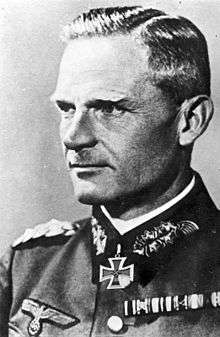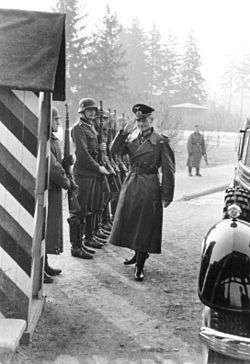Carl-Heinrich von Stülpnagel
| Carl-Heinrich von Stülpnagel | |
|---|---|
 Carl-Heinrich von Stülpnagel | |
| Born |
2 January 1886 Berlin, German Empire |
| Died |
30 August 1944 (aged 58) Plötzensee Prison, Berlin, Nazi Germany |
| Allegiance |
|
| Service/branch | Heer |
| Years of service | 1904–44 |
| Rank | General of the Infantry |
| Commands held | II. Armeekorps |
| Battles/wars |
World War II |
| Awards | Knight's Cross of the Iron Cross |
Carl-Heinrich von Stülpnagel (2 January 1886 – 30 August 1944) was a German general in the Wehrmacht during World War II who was an army level commander. While serving as military commander of German-occupied France and as commander of the 17th Army in the Soviet Union during Operation Barbarossa, Stülpnagel was implicated in war crimes, including authorising reprisal operations against civilian population and closely cooperating with the Einsatzgruppen in their mass executions of Jews.
He was a member of the July 20 Plot to assassinate Adolf Hitler, being in charge of conspirators' actions in France. After the failure of the plot, he was recalled to Berlin and attempted to commit suicide en route, but failed. Tried on 30 August 1944, he was convicted of treason and executed on the same day.[1]
Early life
Born in Berlin, Stülpnagel joined the German military straight from school in 1904, and served as a general staff officer in World War I. After the war he served in the Reichswehr reaching the rank of Colonel in 1933. The same year, he was appointed head of the 'Foreign Armies' branch of the General Staff of the Army.[1] In 1935 he published a memorandum in which he combined anti-Bolshevism with anti-semitism[2] By 1936 he was a Major General and commanded the 30th Infantry Division in Lübeck.
On 27 August 1937 as a Lieutenant General he was appointed Deputy Chief of the General Staff of the Army. In 1938, after the Blomberg-Fritsch Affair and the Sudeten Crisis, he established contact with the Schwarze Kapelle, revealing the secret plan for the invasion of Czechoslovakia. Stülpnagel took part in the military opposition's first plans to remove Hitler from power, but these plans were largely abandoned after the Munich Agreement.
World War II

From 20 December 1940 to 4 October 1941, Stülpnagel was a General of Infantry (April 1939) and commanded the 17th Army. On 22 June 1941, after the launch of Operation Barbarossa, he successfully led this army across southern Russia on the Eastern Front. Under Stülpnagel's command, the 17th Army achieved victory during the Battle of Uman and the Battle of Kiev.
In February 1942, Stülpnagel was made German-occupied France's military commander,[1] and in this position, he, along with his personal adviser Lieutenant-Colonel Caesar von Hofacker, continued to maintain contact with other members of the conspiracy against Hitler.
War crimes
Substantial archival evidence indicates that during his tenure as commander of the 17th Army and military governor of France, Stülpnagel was involved in war crimes. In the Soviet Union, Stülpnagel signed many orders authorizing reprisals against civilians for partisan attacks and closely collaborated with the Einsatzgruppen in their mass executions of Jews. He admonished his soldiers not for the murder of civilian population but for chaotic means in which it was undertaken, particularly early premature taking hostages and random measures. He ordered his troops to focus on Jews and communist civilians, remarking that communists were Jews that needed capture anyways; in order to improve relations with Ukrainians, even in cases of Ukrainian sabotage, local Jews were pointed out for punishment.[3]
20 July plot
On the day in question, 20 July 1944, Stülpnagel put his part of the plot into operation. This mainly involved having Hans Otfried von Linstow, who was only informed of the plot on that same day, round up all SS and Gestapo officers in Paris and imprison them. However, when it became apparent that the assassination attempt in East Prussia had failed, Stülpnagel was unable to convince Field Marshal Günther von Kluge to support the uprising and was forced to release his prisoners. When Stülpnagel was recalled from Paris, he stopped at Verdun and tried to kill himself by shooting himself in the head[1] with a pistol on the banks of the Meuse River. He only succeeded in blinding himself.[4]
Stülpnagel and his adviser were both arrested by the Gestapo, and Stülpnagel was brought before the Volksgerichtshof (People's Court) on 30 August 1944. He was found guilty of high treason and hanged the same day[1] at Plötzensee Prison in Berlin.
Awards
- Knight's Cross of the Iron Cross on 21 August 1941 as General der Infanterie and commander-in-chief of the 17. Armee[5]
See also
- Otto von Stülpnagel - cousin and German military commander of occupied France
Notes
Citations
- 1 2 3 4 5 Correlli Barnett, ed. (1989). Hitler's Generals. Weidenfeld and Nicolson. ISBN 0 297 79462 0.
- ↑ Bulletin, Volume 12-14 German Historical Institute in London, page 27 The Institute, 1990
- ↑ Nazi empire-building and the Holocaust in Ukraine, Wendy Lower pages 54-55 UNC Press 2006
- ↑ Die Wehrmacht: Eine Bilanz, Guido Knopp, p. 258
- ↑ Fellgiebel 2000, p.337.
References
- Fellgiebel, Walther-Peer (2000) [1986]. Die Träger des Ritterkreuzes des Eisernen Kreuzes 1939–1945 — Die Inhaber der höchsten Auszeichnung des Zweiten Weltkrieges aller Wehrmachtteile [The Bearers of the Knight's Cross of the Iron Cross 1939–1945 — The Owners of the Highest Award of the Second World War of all Wehrmacht Branches] (in German). Friedberg, Germany: Podzun-Pallas. ISBN 978-3-7909-0284-6.
- Knopp, Guido Die Wehrmacht: Eine Bilanz, C. Bertelsmann Verlag, München, 2007. ISBN 978-3-570-00975-8
- Anthony Cave Brown, Bodyguard of Lies, Harper & Row, 1975
- Scherzer, Veit (2007). Die Ritterkreuzträger 1939–1945 Die Inhaber des Ritterkreuzes des Eisernen Kreuzes 1939 von Heer, Luftwaffe, Kriegsmarine, Waffen-SS, Volkssturm sowie mit Deutschland verbündeter Streitkräfte nach den Unterlagen des Bundesarchives [The Knight's Cross Bearers 1939–1945 The Holders of the Knight's Cross of the Iron Cross 1939 by Army, Air Force, Navy, Waffen-SS, Volkssturm and Allied Forces with Germany According to the Documents of the Federal Archives] (in German). Jena, Germany: Scherzers Miltaer-Verlag. ISBN 978-3-938845-17-2.
External links
- Carl-Heinrich von Stülpnagel in the German National Library catalogue
| Military offices | ||
|---|---|---|
| Preceded by — |
Commander of 30. Infanterie-Division 1 October 1936 – 4 February 1938 |
Succeeded by Generalmajor Kurt von Briesen |
| Preceded by Generaloberst Adolf Strauß |
Commander of II. Armeekorps 30 April 1940 – 21 June 1940 |
Succeeded by General der Infanterie Walter von Brockdorff-Ahlefeldt |
| Preceded by none |
Commander of 17. Armee 20 December 1940 – 4 October 1941 |
Succeeded by Generaloberst Hermann Hoth |